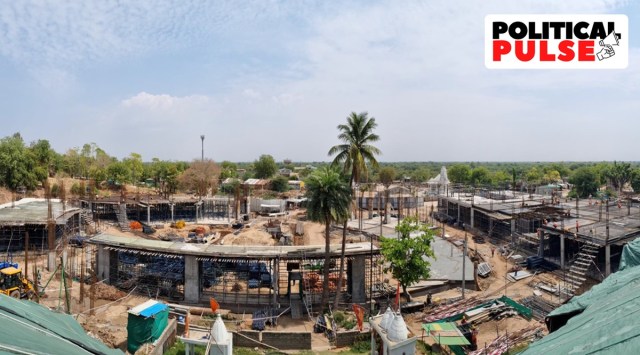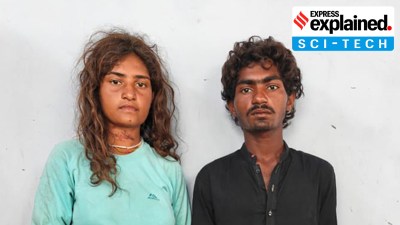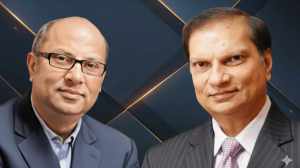History meets future: It’s always prime time in Modi’s Vadnagar
How a sleepy village got transformed to an archaeological treasure, a happening municipality, an educational hub, and now, a “prerna” destination
 Viral Modi, a structural engineer at the site of an experiential museum, talks about “development at full scale on every front, be it education, heritage, infrastructure or health”. (Express Photo)
Viral Modi, a structural engineer at the site of an experiential museum, talks about “development at full scale on every front, be it education, heritage, infrastructure or health”. (Express Photo) It takes a village to raise a child. And sometimes, the story goes the other way.
Vadnagar, many of its old-timers recall, used to be one of those Indian villages, with a high school at most, and no proper roads or tap water. Among its few amenities was electricity, not so common at the time, and a railway station dating from before Independence.
This started changing from around the time Vadnagar’s most famous resident, Narendra Modi, occupied the state chief minister’s chair, and then moved on to become Prime Minister.
Vadnagar is now a municipality, with several projects, institutes and archaeological digs in various stages of progression, plus a ring road with attractive roundabouts, cemented roads, residential societies. Lately, a brand new plan has come on the table – the development of the school Modi went to, as a ‘Prerna Parisar’, where two children from every district of the country will be brought to spend a week each, for “prerna” or inspiration.
By 2040, a Master Plan for Development envisages Vadnagar as a town split into four zones.
About four years after Modi became the CM in 2001, the Gujarat State Archaeology Department started excavations in the area. Earlier excavations, around 1953, had shown remains of a civilization nearly 2,500 years old. The new excavations, between 2005 and 2013, confirmed the Buddhist links of Vadnagar, including traces of monasteries and evidence that famous Chinese traveller Hiuen Tsang had visited the area.
 Lately, a brand new plan has come on the table – the development of the school Modi went to, as a ‘Prerna Parisar’ (Express Photo)
Lately, a brand new plan has come on the table – the development of the school Modi went to, as a ‘Prerna Parisar’ (Express Photo)
The Modi government started an annual Tana-Riri music festival in Vadnagar named after two legendary sisters and gifted singers who, as per local lore, gave up their lives rather than sing in the court of Mughal Emperor Akbar.
Then, the Kirti Toran of Vadnagar – comprising a pair of 12th-century columns supporting an arch — was adopted as the ‘symbol’ of Gujarat, in place of the famed jaali windows belonging to the Sidi Saiyyed mosque of Ahmedabad. Vadnagar’s Sarmishtha lake now has a lakefront, with an open-air theatre.
While campaigning for his first Lok Sabha election in 2014, when he stood from both Vadodara and Varanasi, Modi referred often to how he was fortunate to be born in Vadnagar, that once was under the rule of the Hindu Maratha Gaekwad kingdom of Baroda or Vadodara.
While Modi gave up Vadodara after winning from both the seats, the BJP government and the PM never lost sight of Vadnagar. Among the first guests Modi hosted as PM was Chinese Premier Xi Jinping, and the two spent time together in Ahmedabad, as an ode to those Buddhist links. Similarly, Modi hosted Japanese PM Shinzo Abe in Gujarat in 2017.
 The Prerna Parisar would comprise, besides the restored Kumar Shala No. 1 school building with ground-plus first floor and eight classrooms, an entirely new building adjoining it. (Express Photo)
The Prerna Parisar would comprise, besides the restored Kumar Shala No. 1 school building with ground-plus first floor and eight classrooms, an entirely new building adjoining it. (Express Photo)
Vadnagar and its Buddhist links again came up during Modi’s visit to Nepal in 2022 when, in a speech at Lumbini — considered Buddha’s birthplace — the PM referred to Vadnagar.
In 2016, Vadnagar got a medical college; in 2020, a government science college. In 2021, Modi himself inaugurated a MEMU (Mainline Electric Multiple Unit) train from Gandhinagar to Varetha in Mehsana, with a halt at the Vadnagar Railway Station. A broad gauge line connects Vadnagar now to the rest of the country, with two trains daily running up and down from Gandhinagar and Valsad.
The Vadnagar Railway Station has accordingly seen a major revamp. The redesign includes a giant tea kettle installation and a tea stall preserved with a tin sheet-roof look, on the platform – where a sign says, ‘Bal Narendra sold tea here’. Overseen by the Union Culture Ministry from Delhi, the two installations are part of the “Modi tour” in Vadnagar, which also includes an exhibition of paintings depicting the PM’s life as a tea vendor.
During his first visit as PM to Vadnagar in 2017, Modi had visited the revamped railway station as part of a roadshow.
 Apart from the revamp of Modi’s school as a ‘Prerna Parisar’, there is also an upcoming Archaeological Experiential Museum, and a Music Museum. (Express Photo)
Apart from the revamp of Modi’s school as a ‘Prerna Parisar’, there is also an upcoming Archaeological Experiential Museum, and a Music Museum. (Express Photo)
An archaeologist working on the excavations in Vadnagar since 2015, having moved here from the city to a “culture shock”, talks about the changes he has seen. “Earlier, there were no roads or even streetlights. Though there were a lot of plans, visible changes were seen only after 2010, and more recently after 2016, when the medical college started,” the archaeologist says.
The buildings scattered around Vadnagar, several of them multi-storey, now house the Gujarat Medical Education and Research Society Medical College, education campuses of Government Industrial Training Institute, Government Polytechnic College, and a Jawahar Navodaya Vidyalaya.
Apart from the revamp of Modi’s school as a ‘Prerna Parisar’, there is also an upcoming Archaeological Experiential Museum, and a Music Museum.
The Prerna Parisar would comprise, besides the restored Kumar Shala No. 1 school building with ground-plus first floor and eight classrooms, an entirely new building adjoining it, to be used as a residential campus with a reception and visitor orientation centre. The idea is to tell students “how this one school produced a man who heads the country today”.
Vinodbhai Parmar, who has been employed at the state tourism-run Hotel Toran in Vadnagar for the last 10 months, says: “Before Narendrabhai Modi became the Chief Minister, all Vadnagar had in the name of development was babul trees.”
The Mamlatdar of Vadnagar, Rohit Agara, says: “Numerous projects worth crores have been undertaken in the last two decades.”
Viral Modi, a structural engineer at the site of the experiential museum, talks about “development at full scale on every front, be it education, heritage, infrastructure or health”. “Now, Vadnagar has become an education hub. From primary education to medical education, including arts, commerce, science, nursing and Ayurveda, all are here.”
During his latest visit to the town, G Kishan Reddy — who as Tourism and Culture Minister has been closely involved with the development of Vadnagar — attended the screening of a documentary called ‘Ananth Anaadi Vadnagar (Eternal Vadnagar)’.
“Visiting this place is like a pilgrimage for me,” Reddy said later, adding that Vadnagar would soon feature among the list of historical living cities like Mathura, Ujjain, Patna and Varanasi.
A Gujarat government release on the occasion talked of “the town’s significance as a confluence of seven ancient civilizations, spanning 2,000 years” and spoke of “two projects, worth Rs 277 crore”, to be completed by 2024.
Mukesh Patel, the BJP MLA from nearby Mehsana, says the change Vadnagar has seen in the last 10 years is befitting. “It is Modi saheb’s birthplace and a heritage place too.”
Congress Legislative Party leader Amit Chavda counters that they have no issues with Vadnagar’s development. “But what about the development of other areas? Even today, many people in Gujarat don’t have drinking water, basic infrastructure, children suffer from malnutrition. Entire Gujarat needs basic facilities. What does the government want to project in Vadnagar’s symbolic development? Gujarat has birthplaces of many big leaders and personalities. The government should think about the common people.”
Chavda links this “unequal” development to the ongoing cyclone crisis. “Yesterday, I visited Kutch. They do not have pucca houses even today, and that is the reason thousands have had to be relocated during this cyclone.”


- 01
- 02
- 03
- 04
- 05





























